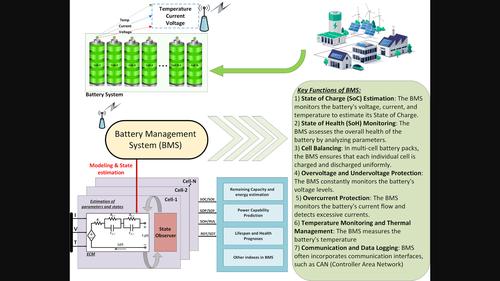电池充电状态估计和管理系统综述:模型与未来展望
IF 5.4
3区 工程技术
Q2 ENERGY & FUELS
引用次数: 0
摘要
电池因其功率和能量密度大的特点,被认为是当今大多数应用中的关键元件。然而,不受控制的充电和放电会对其功能产生负面影响,并可能导致其应用出现灾难性故障。因此,电池管理系统(BMS)是电池正常运行的必要条件。任何 BMS 的关键要素之一都是电荷状态(SoC)估算过程,它高度决定了维持电池健康和效率所需的行动。根据锂离子电池模型或任何其他合适的技术,有多种方法可用于估算锂离子电池(LIBs)的 SoC。本文对现有的 SoC 估算方法和主要锂离子电池模型的优缺点、相互整合以获得精确估算结果的可能性,以及这些技术在电动汽车和公用事业应用中的适用性和这些领域的常用标准和规范进行了深入评述。此外,本研究还将探讨数字孪生(DT)与 BMS 集成的未来框架,以改善先进的管理。根据上述综述,我们可以得出结论:将基于模型的估算技术与数据驱动方法(其发展前景广阔)相结合,以确定电池内部的动态模式,可以在降低这些模型的复杂性的同时,有效地获得精确的估算结果。这种整合还将与数字孪生技术的整合相一致,为 BMS 提供完整而准确的监控。本文章由计算机程序翻译,如有差异,请以英文原文为准。

A review of battery state of charge estimation and management systems: Models and future prospective
Batteries are considered critical elements in most applications nowadays due to their power and energy density features. However, uncontrolled charging and discharging will negatively affect their functions and might result in a catastrophic failure of their applications. Hence, a battery management system (BMS) is mandated for their proper operation. One of the critical elements of any BMS is the state of charge (SoC) estimation process, which highly determines the needed action to maintain the battery's health and efficiency. Several methods were used to estimate the Lithium-ion batteries (LIBs) SoC, depending on the LIBs model or any other suitable technique. This article provides a critical review of the existing SoC estimation approaches and the main LIB models with their pros and cons, their possibility to integrate with each other's for precise estimation results, and the applicability of these techniques in electric vehicles and utility applications with the commonly used standards and codes in these sectors. Moreover, this study will also explore a future framework for integrating digital twins (DTs) with BMSs for improved and advanced management. Based on this comprehensive review, it can be concluded that merging the model-based estimation techniques with the data-driven approaches with their promising development to determine the dynamic patterns inside the battery can efficiently achieve precise estimation results while reducing the complexity of these models. This integration will align also with the integration of digital twin technology to provide complete and accurate supervision for the BMSs.
求助全文
通过发布文献求助,成功后即可免费获取论文全文。
去求助
来源期刊

Wiley Interdisciplinary Reviews-Energy and Environment
ENERGY & FUELS-
CiteScore
11.70
自引率
3.30%
发文量
42
期刊介绍:
Wiley Interdisciplinary Reviews: Energy and Environmentis a new type of review journal covering all aspects of energy technology, security and environmental impact.
Energy is one of the most critical resources for the welfare and prosperity of society. It also causes adverse environmental and societal effects, notably climate change which is the severest global problem in the modern age. Finding satisfactory solutions to the challenges ahead will need a linking of energy technology innovations, security, energy poverty, and environmental and climate impacts. The broad scope of energy issues demands collaboration between different disciplines of science and technology, and strong interaction between engineering, physical and life scientists, economists, sociologists and policy-makers.
 求助内容:
求助内容: 应助结果提醒方式:
应助结果提醒方式:


